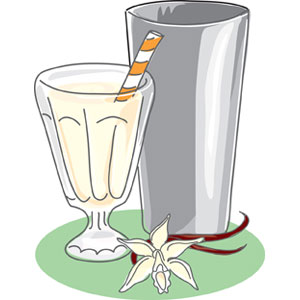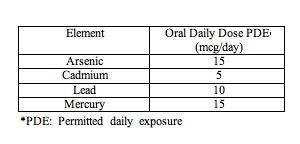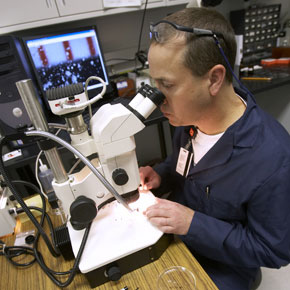Drinking heavy metals

A significant amount of media attention has been given to the recent study (July-Aug issue) in Consumer Reports (CR) of several protein supplements for their alleged content of certain heavy metals.
Concerned consumers have been returning containers of the named products while affected manufacturers have been working overtime to refute the CR study. As an athlete familiar with using protein supplements on a regular basis and as a Ph.D. chemist having worked in an analytical laboratory that included testing of drug product for heavy metals, I hope the following brief summary may be of assistance for concerned and confused Slowtwitch.com readers.
The CR study analyzed 15 protein samples for arsenic, cadmium, lead and mercury. The amount tested was three (3) servings as defined by the product label that ranged from 78g to 237g of powder and 990 mL to 1500mL of liquid product. CR presents their final data in the table below.
What CR found is summarized in the above table and the bold numbers clearly indicate levels of some heavy metals that exceed the published US Pharmacopoeia (USP) daily limits for adults. One of the manufacturers affected opined that the USP limits apply to a relatively low adult weight, however, USP does not provide weight/weight limits and so the static upper limit should apply in a similar way that radiation exposure is recognized as an absolute value and not related to subject weight. The dangers of accumulating heavy metals in an organism is a significant issue.

Why are these particular heavy metals of any consequence? Lead, mercury, arsenic, and cadmium fall within what are called Class 1 elemental impurities. These elements should be essentially absent as they are known or strongly suspected human toxicants and environmental hazards. In the world of pharmaceutical drugs, due to their unacceptable toxicities or deleterious environmental effects, Class 1 impurities should not be present in a drug substance, excipient, or drug product.

However, if their presence is unavoidable, their levels should be restricted as per the chart adjacent. Nutritional supplements are not regulated in the same way as drugs and in fact the US Food and Drug Administration (FDA) does not require testing for heavy metals, but provides for nutritional supplement manufacturers to ensure that no material that is not on the product label is contained within the product, and allows each manufacturer to ensure self-compliance with these regulations. Nutritional supplements ought to be held to a higher standard, but that's the topic of another discussion.
Heavy metals testing is actually a very simple and straightforward analytical procedure. While the CR report does not identify the methods used for testing, it is reasonable to expect that standard laboratory methods have been followed, including correct calibration and reference materials. The fact that some of the samples tested demonstrated levels of heavy metals below the detection limit of the method tends to suggest that no exogenous source (sample matrix, etc…) added any metal content, and the values presented are likely valid. However, CR should have disclosed additional information on its testing protocol.
A serious issue arises with the vast difference between sample sizes. While CR utilized 3 times the exact serving size as prescribed by the manufacturer, the sample size variation ranged from 78g to 237g of powder and 990 mL to 1500 mL of liquid product. Unlike many foods that have standard serving sizes (for example, a serving of cheese is 1 oz/28g), protein supplement serving sizes are assigned by the manufacturer. Unfortunately, CR treated this study as they would for comparing the characteristics of cheese, with the justification that it is often the case that athletes consume 3 servings of these supplements per day.
While that may be the case for some athletes, it would be been much more representative to compare the products by weight and not by serving size. A comparison by weight would have leveled the results and the products that exceeded the USP limits would likely have passed scrutiny. CR did a disservice to its readership by ignoring the serving weights. Rigorous scientific studies should be based on fact and the results in CR are probably factual but presented in a misleading manner. I have taken it upon myself to recreate the CR solid protein results from their table, standardizing a 3-serving daily intake to 100g of powder. The results are:

As you can see by the table, consuming less that 100g of any of these supplements tested falls below USP limits and would not have generated any of the news headlines. However, the fact remains that some of these products DO contain heavy metals according to the testing and long term or excessive use could result in accumulation of heavy metals in athlete's bodies. So it would appear the point of the article may have been more accurately to highlight the presence and dangers of heavy metals in some products, but not to ring alarm bells that these values exceed any particular threshold. With a large enough sample size just about any substance will reveal its impurities.
How much protein do athletes actually need? Existing guidelines range greatly. The Consumer Reports investigation notes that consumers can roughly calculate how many grams of protein they need by multiplying their body weight by 0.4. For athletes, the general rule of thumb is about 1 gram of protein per pound of body weight per day. Considering a significant intake of protein from normal food, consuming in excess of 100g of a protein supplement would appear largely unnecessary, though large athletes and those bulking up could certainly exceed the 180g protein intake that 3 servings of one product provides.
In the opinion of this writer, both CR and the affected manufacturers should work together for better communication and more rigorous scientific scrutiny. The published research is a "good start" but clearly additional studies are needed. CR may be faulted for carrying out what appears to be an incomplete and poorly-designed study and the manufacturers may be chastised for allowing any detectable level of heavy metals into their products when alternative raw material sources exist with lower levels of metals. However, it's through scrutiny such as this study that these issues come to light and all parties involved can make efforts towards safer products.
General recommendations
Based on the CR report, at this time there is no clear evidence that protein supplements are of significant danger in "normal" usage quantities. However, it is reasonable to exercise caution when consuming excessive protein supplements and to limit daily intake to less than 100g per day, a level that still exceeds normal protein requirements for active individuals. Pregnant women and smaller individuals (including children and teens) should be particularly careful and refrain from excessive protein supplement intake.
It is also helpful to remember that many foods contain natural levels of metals and that it is impossible to avoid all exposure to these heavy metals. Even when the heavy metal content remains below USP limits, when supplements are combined with normal daily food intake, it is readily possible for individuals to exceed the daily USP limits.
It is equally troubling that CR lacks rigorous data interpretation and omits the testing parameters. As a neutral organization dedicated to consumer protection, CR should consider making all data relating to its studies subject to the same public scrutiny as peer-reviewed scientific research. considering the broad-reaching effect (positive or negative) that their results can have, they owe it to their readers to reach for the highest uncompromising standards. And as with all nutritional supplements, consumers should weigh the benefits and risks of consumption and make informed choices whenever possible.
Jonathan Toker is the Slowtwitch Science Editor. He is an elite-level runner-triathlete who hails from Canada and lives in Southern California. He received a Ph.D. in organic chemistry from The Scripps Research Institute in 2001. Jonathan invented the SaltStick brand.




Start the discussion at slowtwitch.northend.network